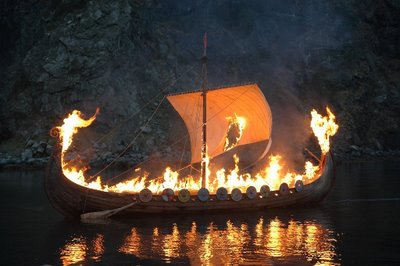In the Viking imagination, female figures were not just mothers or wives. There was a fascinating and powerful archetype: the völva, a priestess, sorceress, or seer who walked between the world of mortals and that of the gods.
Their role was essential in Viking rituals, funerals, prophecies and key decisions for clans and kings.
This article explores the spiritual heart of Norse society, showing who these sacred women really were and how their influence shaped everyday life.

What was a völva?
The word völva comes from Old Norse and means "she who carries a rod," symbolizing her spiritual power.
The völvas were wise women, respected and dedicated to the magical arts, prophecy and connection with the gods.
They were consulted by kings, clan chiefs and peasants before battles, journeys or harvests.
They were not priestesses of a fixed temple, but rather itinerant mystics who traveled through Nordic villages and fjords, practicing their art independently.
His prestige was linked to his ability to interpret runes, omens and dreams.
Historical sources on the völvas
Several Norse sagas mention the völvas with both admiration and fear.
In the Saga of Erik the Red, a völva named Þorbjörg was invited to predict the future of a community.
In the Völuspá, a poem from the Poetic Edda, a völva recounts the origin of the world and its end during Ragnarök.
In the Oseberg burial, one of Norway's richest archaeological finds, two female skeletons were found accompanied by extraordinary funerary trousseau: a ceremonial chariot, tapestries, cult objects, and a wooden staff that many archaeologists interpret as a seiðstafr (magic wand associated with the völvas).
Based on the objects found in the grave, archaeologists believe it may contain the body of a noble völva, confirming the importance of these women in Viking society.

Clothing and ritual objects
The attire of a völva reflected her special position.
They wore long dresses, capes dyed dark blue or purple, and ritual jewelry made of bronze, silver, or amber.
The belts were decorated with amulets, ceremonial knives and bags of herbs.
The most distinctive object was the iron or bronze ritual rod, a symbol of spiritual authority, often engraved with runes or magical spirals.
In addition, they wore headdresses or ritual caps, possibly as a sign of their connection to the gods or invisible powers.
Seiðr rituals and magic
The völvas practiced seiðr, a form of Norse magic that involved entering a trance or ecstasy, accompanied by chanting and rhythmic repetition.
They invoked deities such as Freya and Odin, performed divinations, dream interpretations, rune readings, and omens in nature.
They also performed curses and blessings, using knots, dolls or symbols.
Seiðr carried spiritual risks and contact with chaotic forces, so völvas were both feared and revered in Norse society.
Independence and status
A völva did not belong to a husband or a specific clan. Her power gave her independent status, sometimes even superior to that of village chiefs.
She was hosted with honor, received gifts and special food, and could refuse help if she was not treated with respect.
Many were older women, widows or childless, reinforcing their connection to the other world and their freedom of movement.
Her role in Viking society demonstrated that women could exercise spiritual leadership and autonomy in a world dominated by warriors and kings.

Were the völvas witches?
The word "witch" has different connotations depending on the era.
In the Viking world, a völva was more of a shaman or prophetess than a malevolent sorceress.
After the Christianization of Scandinavia, many volvic practices were considered pagan and persecuted as witchcraft.
For centuries, their legacy was demonized or hidden, until modern studies and archaeological discoveries restored the völvas to their place in the history of Norse society.
Symbolism and legacy
The völvas symbolize feminine wisdom, connection with nature and spiritual power.
They inspired feminist writers, research on European shamanism, and modern guides to Nordic spirituality.
Her figure remains a symbol of female autonomy, spiritual leadership, and mystical guidance, reflecting the cultural and spiritual richness of the Viking Age and its historical significance.
Don't miss the opportunity to visit our Medieval Shop and see our Viking Collection .









